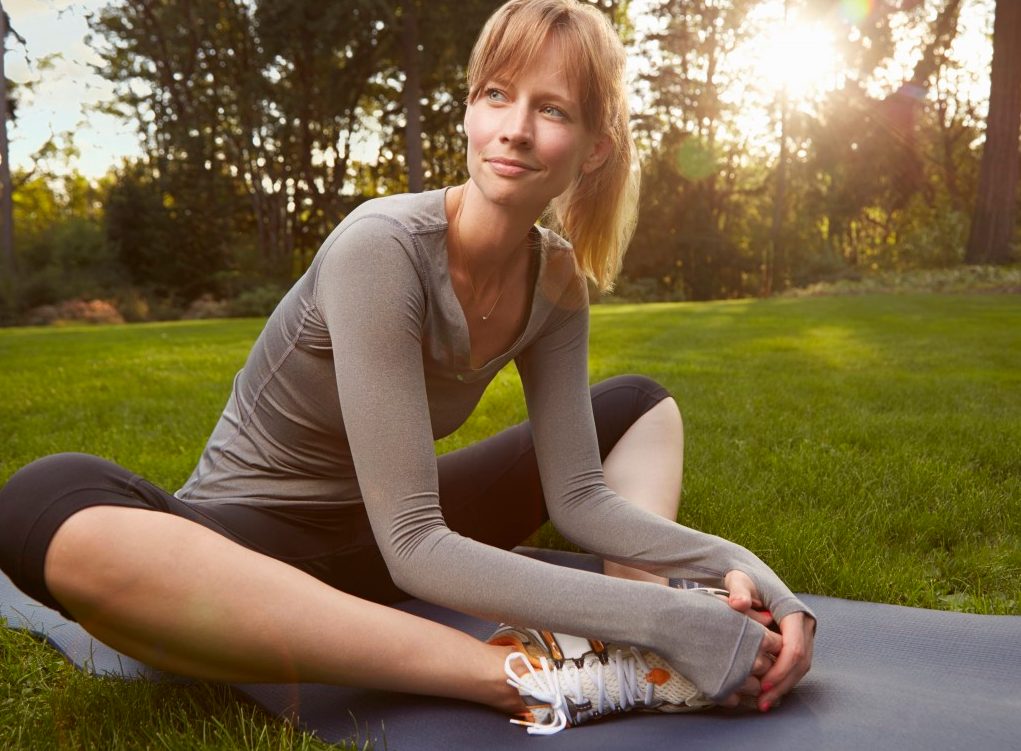Stretching Relief for Hip and Back Pain

Excessive sitting, especially day after day, causes the group of muscles in your hips to shorten. Here’s our step-by-step guide to counteract the effects.
Like so many who work at a desk or use a computer, Linda Yeazel spends most of her day sitting. When she gets up after a period of relative immobility, her first few steps are often uncomfortable.
"It takes me a minute to get my gitalong going," Yeazel says. She’ll often stand up and stretch a little before taking those first few steps. "I feel stiff, and it feels like I need to walk it out.” Yeazel says she’s developed a near constant pain in her left hip but notes that moving around helps.
YOU MIGHT ALSO LIKE: Knee Strengthening Exercises
Excessive sitting, especially day after day, causes the group of muscles in your hips (called the hip flexors) — generally the psoas major, iliacus, sartorius, and rectus femoris — to shorten and become tight and stiff. Tight hip flexors can make it difficult to stand up straight and take a full stride, leading to an achy back and hips. If you spend the day looking at a computer screen, chances are you’re leaning forward, affecting your neck, shoulders, and upper back. Few people have the strength in their back and abdominal muscles to maintain good posture over hours of sitting. In this constant tug-of-war, gravity will usually win.
The hip flexors are also connected to the lumbar spine of your lower back. Tension in these muscles from habitual sitting can pull at your lumbar spine, resulting in back pain, which may be aggravated further if you sit with your legs crossed.
To get relief, many people make regular visits to their chiropractor, massage therapist, or both.
Stretching will go a long way
- You can do split stance reaches anywhere, without any equipment. See how with this video.
- The same is true of fire hydrants, demonstrated here.
This video of the supine groin progressive stretch will help you relax and realign the parts of your body that get out of whack from so much sitting. You’ll need a chair, a pair of flat boots or high-top shoes, and five rolls of toilet paper.
- Stack the rolls of toilet paper against a wall. Make sure there’s enough space in front of the stack for you to lay down on the floor. The surface should be firm; you may want to use a yoga mat.
- Place the boot or shoe on the foot you will start with.
- Lay down on the floor with the working foot on top of the stack of toilet paper and your foot supported by the wall. Your leg should be straight, and the support of the boot and the wall should prevent your foot from rolling out, allowing you to completely relax your leg.
- Place the other leg on the chair or block in a 90-degree angle.
- Lay back so your extended leg and body are in alignment.
- Place your arms on the floor at a 45-degree angle to your torso, with palms up.
- Relax. Allow your hips, back, arms, shoulders, and head to sink into the floor.
Initially, you may feel a curvature in your lower back. This is normal. As you lay there,. your hip will slowly release, and your back will flatten. Stay in this position until your back is completely flat on the floor. This may take anywhere from three to 10 minutes. Don’t rush. Once your back is flat, remove one of the toilet paper rolls and repeat. Continue the sequence until all of the toilet paper rolls have been removed and your leg and back are flat on the floor. Repeat on the other side.
It’s true that this sequence takes some time, but, compared with the amount of time you spend sitting each week, it’s a drop in the bucket. An added benefit is the relaxation and release of tension in your upper back, shoulders, and neck.
Other ways to stretch
If you want to be more proactive about avoiding stiffness and tension in your low back and hips, you can try a number of stretches, even some at your desk. It’s also important to incorporate core strengthening exercises targeting your abdominal muscles as well as your hips and back.
And don’t forget to get up and move around at least once an hour. Even a little movement can significantly improve many of the negative effects of too much sitting.
Updated:
March 01, 2022
Reviewed By:
Christopher Nystuen, MD, MBA and Janet O'Dell, RN